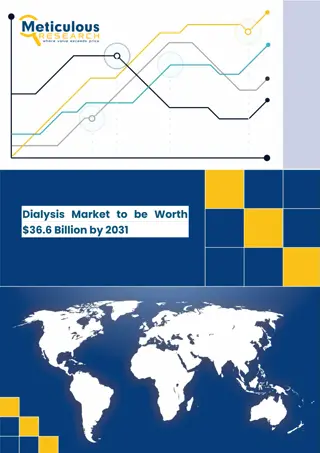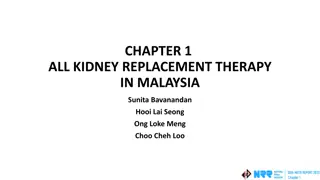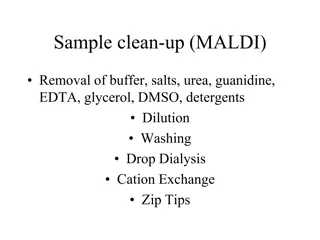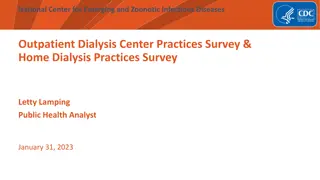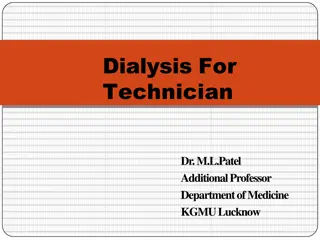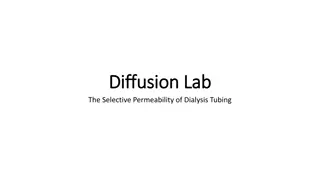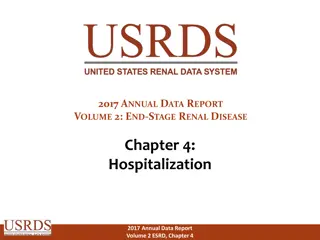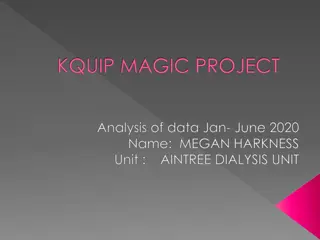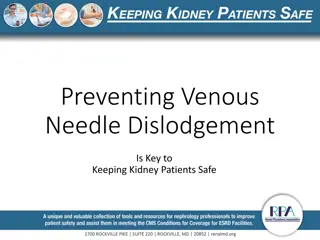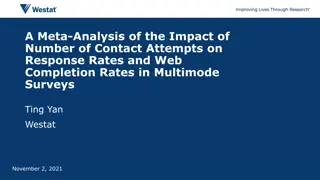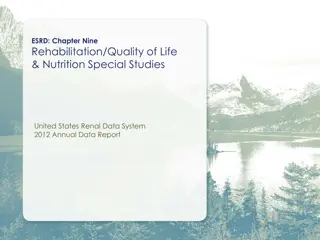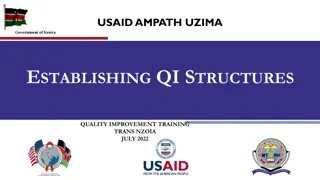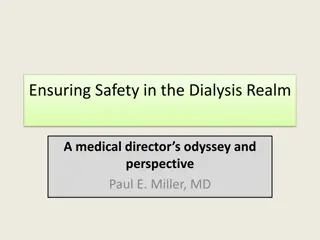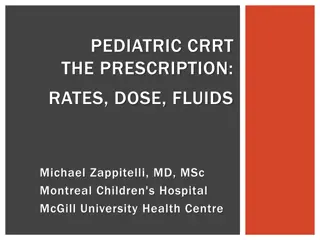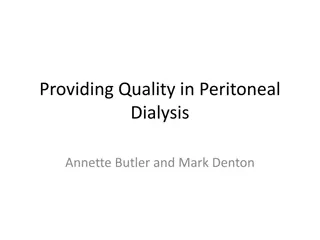Enhancing Home Dialysis Rates: A Quality Improvement Initiative
Initiating a Quality Improvement Activity (QIA) to increase the number of patients opting for home dialysis through a comprehensive 7-step process. The goal is to promote referral to home modalities, identify barriers, and enhance patient-provider collaboration. Criteria for facility and patient inclusion/exclusion, success metrics, and network expectations are outlined for successful implementation.
Uploaded on Sep 22, 2024 | 1 Views
Download Presentation

Please find below an Image/Link to download the presentation.
The content on the website is provided AS IS for your information and personal use only. It may not be sold, licensed, or shared on other websites without obtaining consent from the author.If you encounter any issues during the download, it is possible that the publisher has removed the file from their server.
You are allowed to download the files provided on this website for personal or commercial use, subject to the condition that they are used lawfully. All files are the property of their respective owners.
The content on the website is provided AS IS for your information and personal use only. It may not be sold, licensed, or shared on other websites without obtaining consent from the author.
E N D
Presentation Transcript
2018 Increase Rate of Patients Dialyzing at Home Using the 7-Step Process Quality Improvement Activity (QIA) Donna DeBello, RN Quality Improvement Director Health Services Advisory Group (HSAG): End Stage Renal Disease (ESRD) Network 7 January 31, 2018
Orientation Webinar Housekeeping To verify facility attendance, please send an email after the call with the names of the facility and attendees to Donna DeBello atddebello@nw7.esrd.net. This webex is being recorded for attendance purposes. This is a phone conference, so please mute your phone. To mute/un-mute *6 2
Webinar Agenda QIA Introduction, Criteria, Goals Interventions and Timelines QIA Data Reporting Patient and Family Engagement Learning and Action Network (LAN) Best Practices for Success and Sustainment Addressing Health Disparities Questions 3
QIA Introduction Home modalities are underutilized in the U.S., with only 8% of dialysis patients on a home modality compared to 92% being treated in-center. The intent of this QIA is to: Promote referral to home modalities. Identify barriers to timely referral. Determine the steps patients and providers can take to improve referral patterns. 4
QIA Facility Inclusion Criteria For facility inclusion: The Network identified 30% of facilities within the Network service area for participation based on their percentage of patients training on a home modality during the period of October 2016 to June 2017*. For patient inclusion: An eligible patient is any patient who is a non-transient patient and is not currently on a home modality. For patient exclusion: Patients will be excluded if they: Are not interested in a home modality and it is documented in their patient record. Are currently a home patient on back-up hemodialysis. Have a medical exclusion documented in their patient record and reported to the Network. 5 *Source: Centers for Medicare & Medicaid Services (CMS)
Network Criteria for Success For patient credit: Patient initiates home training (Step 7) A patient will be considered initiated when the Dialysis Training Start Date is recorded in the CROWNWeb treatment record. For facility credit (referring facility): The facility that treats the patient directly prior to the admission/treatment record with a Training Start Date, will be considered the Referring Facility andwill receive credit. For successful completion of QIA Facilities must demonstrate a 10 percentage point increase in the number of eligible patients training on a home modality from the baseline by July 2018. 6
QIA Goals Increase in the number of eligible patients training on a home modality within a targeted group of in-center dialysis facilities. 10 percentage points over baseline Improve collaboration between in-center staff and home modality staff. Improve knowledge of home modalities for in-center staff. To provide needed support to patients transitioning to home training. Improve the tracking and transitioning of eligible patients training on a home modality using the7-Steps to Home Training tracker. 7
Interventions Complete root cause analysis (RCA) Use the 5 Why s. Activate the Plan-Do-Study-Act (PDSA) cycle. Identify barriers in the 7-Step process to patients initiating home training Report findings in the Initial Assessment Survey Monkey link provided by the Network. Partner with home programs Identify a lead home nurse and experienced home dialysis patients to collaborate for assistance with home modality education. 8
Interventions (cont.) Educate staff Collaborate with lead home nurse to provide an in-service or homeroom education session. Educate Patients Provide education to eligible patients. Encourage a current home dialysis patient to act as mentor and support through the 7-Step process to home training. Build Relationships Collaborate with Medical Director and nephrologists to identify local surgeons for timely patient appointments and follow up. 9
Interventions (cont.) Attend the ESRD National Coordinating Center (NCC) LAN per CMS guidelines It is mandatory that each facility in the Home QIA attend the ESRD NCC LAN every other month. Attendance will be tracked by the Network and reported to CMS monthly. Implement patient and family engagement activities Include patient subject matter experts (SMEs) in all patient- related activities for this QIA. Identify and report best practices Share and report monthly activities that have assisted in the timely navigation of in-center patients through the 7-step process to home training. 10
PDSA Cycle 11
Monthly Reporting via Survey Monkey For 2018, monthly reporting will be completed/submitted via Survey Monkey. Links to the specific month s reports will be provided to you by the Network and will include links to: The Initial assessment report with RCA and barriers to each of the 7- Steps to home training. Due February 15 Monthly reporting from March September. Due on the 5th of the reporting month for the month prior. 13
7-Steps to Home Training 1. Patient Home Dialysis Interest Implement the HomeModality Patient Interest Questionnaire with new and existing patients. 2. Modality Preference Educate patients on home modalities and document patient preference. 3. Patient Suitability Review the Method to Assess Treatment Choices for Home Dialysis (MATCH-D) with the Interdisciplinary Team (IDT) and nephrologist to assess patient suitability. 14
7-Steps to Home Training (cont.) 4. Schedule Appointment for Appropriate Access Assist nephrologist in timely coordination of surgical consult. 5. Access Placement Track appointment for timely follow-up with surgeon. 6. Accepted Into Home Program Collaborate with lead home nurse for patient training schedule date. 7. Initiates Home Training Coordinate transition of patient from in-center to home modality with lead home nurse and document in CROWNWeb. 15
Patient and Family Engagement at the Facility Level CMS requires that the Network: Ensure the implementation of interventions at the dialysis facility level that foster patient and family involvement. Assist facilities in adjusting to the heightened focus on patient and family centered care by providing technical assistance on: Establishing a patient and family council support group and/or new patient adjustment group. Incorporating patient, family, and caregiver participation into the Quality Assurance Performance Improvement (QAPI) Program and governing body of the facility. Developing policy and procedures related to patient, family and caregiver participation in patient care. 18
NCC Home Dialysis LAN Each facility must participate in the NCC Home Dialysis LAN calls. LAN calls begin in February and will then be held ever other month. LANs are: A forum for patients, family members, caregivers, providers, and other stakeholders to share ideas around a shared goal. Mechanisms by which large scale improvement toward the achievement of a person-centered outcome based goal is fostered, studied, adapted, rapidly spread, and sustained. Regardless of the change methodology, tools, or time-bounded initiative used. 19
Best Practices: Success and Sustainment Best practices for successful completion of this QIA and sustainment of progress made include: Identifying a home lead nurse, home patient mentors, and SME s. Collaborating with modality educators to offer comprehensive home modality education. Tracking patients through each of the 7-Steps toward home training using either the 7-Steps to Home Dialysis tracker or an internal tracker. Providing continuous timely support of patients through the 7-Steps to home training. Hosting a Lobby Day to coordinate a meeting between interested patients and family members and existing patients dialyzing at home. Reporting monthly to the Network via the Survey Monkey links provided. Building relationships and collaborating with the medical director and nephrologists to identify local surgeons for timely appointments and patient follow-up. 20
QAPI During monthly QAPI meetings: Introduce your inclusion in this QIA meeting to engage the support of your medical director and IDT. Discuss the patient interest questionnaires and assess patients for suitability using the Match-D. Discuss individual patients progress through the 7- steps, barriers encountered at each step, and resolutions designed by your team that may be shared as best practices. 21
Health Disparities Health disparities are differences in health outcomes closely linked with social, economic, and environmental disadvantage are often driven by the social conditions in which individuals live, learn, work, and play. Characteristics including race, ethnicity, disability, sexual orientation or gender identity, socio-economic status, geographic location, and other factors historically linked to exclusion or discrimination are known to influence the health of individuals, families and communities. An additional resource from the Centers for Medicare and Medicaid Services (CMS) will be sent out to all participants with more information. To learn more contact: HealthEquityTA@cms.hhs.gov Source: Centers for Medicare & Medicaid Services 22
Resources Monthly planner (timelines) Network will send out after webinar Link to the MATCH-D patient suitability assessment http://homedialysis.org/match-d Link to a disparity resource from CMS Guide to Preventing Readmissions Among Racially and Ethnically Diverse Medicare Beneficiaries found at http://https://www.cms.gov/About-CMS/Agency- information/OMH/Downloads/OMH_Readmissions_Guide.pdf The RCA 5 Why s process https://open.buffer.com/5-whys-process 23
Questions 24
Thank you! Donna DeBello, RN 813.865.3363 ddebello@nw7.esrd.net This material was prepared by HSAG: ESRD Network 7, the Florida Network, under contract with the Centers for Medicare & Medicaid Services (CMS), an agency of the U.S. Department of Health and Human Services. The contents presented do not necessarily reflect CMS policy nor imply endorsement by the U.S. Government. FL-ESRD-7G004-01302018-01 25


